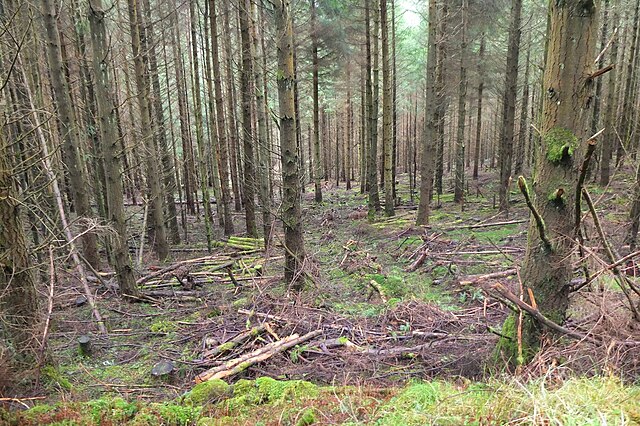The long lifetime of carbon dioxide in the atmosphere might be the most difficult challenge posed by climate change. Last year alone, fossil fuel burning dumped an estimated 37 billion tons of this greenhouse gas into the atmosphere, while changes in land use, mainly from deforestation and agriculture, contributed 10-15% more. Unlike methane, which has a short atmospheric half-life of just nine years, some of the CO2 we emit persists in the air for hundreds to tens of thousands of years. This means that excessive global heat, and its consequences for extreme weather, will still persist for a very long time even if we are successful in achieving “net-zero” emissions by mid-century.
The goal of “net zero” incorporates the concept of atmospheric CO2 removal. This idea has become mainstream climate policy because a relatively small fraction of emissions, especially in agriculture and heavy industry, are probably impossible to eliminate within the few decades we have to act. So the “negative” emissions associated with removing some atmospheric CO2 would compensate for this.
Some of the carbon removal could be accomplished by natural land management, especially through reforestation, afforestation of previously unforested land, and carbon-conserving methods in agriculture. But increasingly, it is becoming clear that there are significant limits to the amount of CO2 that can likely be sequestered by these approaches. Climate change is already reducing the capacity of the land and oceans to absorb our emissions, and we will be fortunate to avoid one or more planetary tipping points that could make this situation much worse. Further, the amount of carbon we must remove is staggering, far in excess of what it will take to stabilize “net zero” levels. Our obligation to future generations means that we will need to reduce CO2 levels from a best-case stabilized concentration of 450-500 ppm to 350 ppm or even lower. How will we do this?
Today, no industrial approach to lowering atmospheric CO2 levels comes even close to working cost-effectively at the necessary scale, although there is no shortage of ideas. These can be very roughly divided by where the carbon is sequestered – either on land or in the oceans. Land-based methods include capturing CO2 directly from the atmosphere and injecting it deep underground (direct air capture; DAC), burning biomass in an electric power plant while capturing and burying the emitted CO2 (bioenergy with carbon capture and storage; BECCS), and enhanced weathering (spreading CO2-absorbing rocks across very large surfaces). The ocean methods include enhancing photosynthesis of marine plants by iron fertilization, and adding alkaline chemicals to cause dissolved CO2 to mineralize and sink to the seafloor.
Among these possibilities, DAC might have the most promise as a long-term solution. Generous US tax credits are spurring the entry of a number of startup companies into the field, and some early milestones, while still modest in scale, are within view. DAC benefits from industry experience with capturing CO2 from manufacturing and power plant smokestacks, and has a number of other advantages: the facilities can be localized directly at the sites of injection, the technology for safe, permanent and EPA-regulated deep burial in saline aquifers is developing well, and the potential for negative ecological consequences is lower than for other approaches, especially the ocean-based methods.
Nonetheless, the very dilute level of atmospheric CO2 means that enormous amounts of carbon-free energy are required to capture it in the DAC facilities. This is a huge problem akin to what faces the development of a new green hydrogen industry driven by solar and wind-powered electrolysis. Further, the amount of effort needed to explore, establish and properly permit new geologic sequestration sites should not be underestimated. Indeed, to date, only a few US states have the necessary regulations in place. For these reasons it seems increasingly unlikely that DAC will contribute substantially to carbon removal in the next few critical decades. We badly need a rapidly deployable, low-energy approach to supplement natural land management, allowing sequestration of significant amounts of carbon in the near term to meet “net zero” goals. This could buy us the time needed to eventually deploy DAC at a cost effective, commercial scale in the second half of the century.
Cue the humble technology of wood burial. In 2013, while exploring potential field sites, a team of American and Canadian scientists discovered an ancient and remarkably well preserved red cedar log under a deposit of fine clay. The log was found just two meters below the ground surface in southeastern Quebec, near the US border with Vermont. Analysis of the wood by carbon dating showed that it was buried about 3800 years ago, and further tests of its chemical composition in comparison with modern red cedar samples showed that at least 95% of the carbon in the log was preserved. In most circumstances, a log buried at such shallow depth would have been rapidly decomposed by fungi and insects. In this case, however, the combination of a water-saturated soil and thin, impermeable clay barrier created an environment depleted in oxygen, where these organisms cannot survive. The discovery highlights the potential of wood burial to sequester carbon on a millenium time scale, and it is creating enthusiasm for development of a new, low-tech industry to mitigate global warming.
The major advantage of wood burial is that it draws from existing unexploited wood resources, especially forest thinnings sometimes already targeted for removal to enable wildfire prevention. Thus, there is no need to dedicate land and resources to grow new biomass. To estimate the potential of the approach, the scientific team used a global carbon cycle model to determine how much new biomass is created each year by natural photosynthesis. About one-sixth of that amount is coarse woody biomass, consisting of trunks and larger limbs, which is more easily preserved because it resists decomposition by microorganisms that thrive in environments lacking oxygen. Only this portion of the wood resource was considered. From this value the team then excluded collection from forest areas dedicated to conservation and habitat protection, and those located on very steep terrain where operations would be difficult. Further subtractions considering the potential for commercial uses of the wood thinnings, and other uses of the land, were also applied. The final estimate is that wood burial could contribute an estimated global yearly potential of about 10 billion metric tons of CO2 removed from the atmosphere. This is comparable to the estimated yearly amount of needed CO2 removal by mid-century, to enable reaching net-zero emissions.
Wood burial in dedicated “wood vaults” is cost-competitive with other carbon removal technologies, as it uses technology that is already well-developed in the timber and construction industries. The main costs involve excavation of the vaults, transport of clay soil to the site when needed, and transportation of recovered wood to storage facilities where it is held before burial. The team estimates a current cost of $100-$200 per ton of sequestered carbon, considering all possible expenses including monitoring, reporting and verification, wood sourcing (though much of the wood may be free) and transaction costs. This is in the same range as other technology-based carbon dioxide removal methods. The technology is a clear candidate for earning credits in voluntary global carbon markets, which has good potential to stimulate development of the industry.
The $100-$200 per ton cost range can be compared to the costs incurred in the world’s first commercial wood burial project, executed by the company Carbon Lockdown, in Maryland. Their Potomac Project, illustrated in an entertaining video, required 50 mile one-way transport of 100 tons of wood from its urban waste wood collection site, and came in at a cost of $105 per ton. This wood would have been mulched, and its carbon soon returned to the atmosphere, had the project not been carried out. Substantial sums are also being made available from Bill Gates’ climate fund and other sources, which is enabling a number of other new companies to get started in the field.
The team estimates that, after further development and consolidating project efficiencies, costs should decrease to $30-$100 per ton. Of course, project costs around the world will be highly variable depending on many details of the local harvesting and transport. Further research is also warranted to look into how the design of the vaults might best accommodate preservation of different kinds of wood.
Wood burial is a hybrid approach that incorporates elements of both natural land management and human industry. It has the virtue of being easily implemented around the world, and could be especially valuable in developing nations from the global South, which have sizable forest resources and a good fraction of the global wood burial sequestration potential. The provision of carbon credits to local companies can provide a valuable new income source that works against the competing incentive to earn money by harvesting forest products and cutting forests down. Reliable monitoring and verification will be an essential part of the developing industry dynamic, to ensure that carbon credits are backed by tangible sequestration of the CO2.

